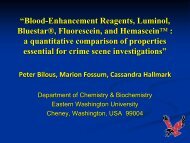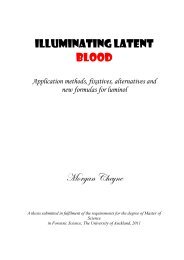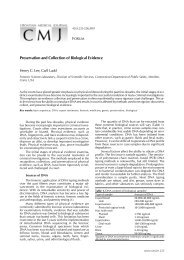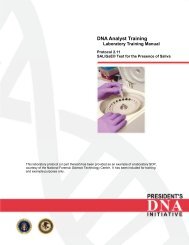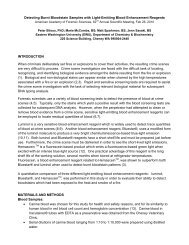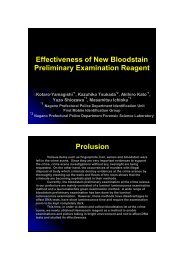Modern methods of collection and preservation of biological
Modern methods of collection and preservation of biological
Modern methods of collection and preservation of biological
Create successful ePaper yourself
Turn your PDF publications into a flip-book with our unique Google optimized e-Paper software.
Blood from a Person<br />
It is always necessary to collect reference samples from suspects <strong>and</strong> victims. In the great<br />
majority <strong>of</strong> cases, these samples consist <strong>of</strong> liquid blood.<br />
Liquid blood from a person should be collected by qualified medical personnel. The crime<br />
laboratory should be informed if the subject had recently received a blood transfusion <strong>of</strong> any kind.<br />
Two tubes <strong>of</strong> blood, about 5 mL each, should be collected in vacutainers with EDTA as<br />
anticoagulant. In the case <strong>of</strong> collecting reference samples from postmortem subjects, a blood sample<br />
should be obtained from non-body cavity areas such as heart or major internal blood vessels.<br />
Each tube should be labeled with the date, time, subject’s name, location, collector’s name,<br />
case number <strong>and</strong> exhibit number.<br />
Blood samples must be refrigerated, not frozen, <strong>and</strong> submitted to the laboratory as soon as<br />
possible.<br />
Liquid Blood Specimens at Crime Scenes<br />
Liquid blood should be collected with a clean (preferably sterile) syringe or disposable<br />
pipette <strong>and</strong> transferred to a clean (preferably sterile) test tube. A blood clot can be transferred to a<br />
clean test tube with a clean spatula. A clean cotton cloth can be used to soak up liquid blood or a<br />
blood clot (avoiding areas containing only serum). Wet blood samples, if they are collected, must be<br />
preserved in a suitable anticoagulant <strong>and</strong> kept in a refrigerator. These specimens should be<br />
submitted to the laboratory as soon as possible.<br />
Label the specimens with case number, item number, date, time, location, <strong>and</strong> evidence<br />
collector’s name.<br />
Wet Bloodstains<br />
Small objects bearing wet bloodstains should be allowed to air dry, then collected as is. An<br />
effort should be made to preserve the integrity <strong>of</strong> any bloodstain patterns during packaging <strong>and</strong><br />
transportation.<br />
Large objects that cannot be removed from a crime scene may have wet bloodstains on<br />
them. The wet blood should be transferred onto clean cotton cloth.<br />
Bloodstained cotton cloth must be allowed to air dry before packaging in a paper container.<br />
Each object <strong>and</strong> container must be properly labeled.<br />
Dried Bloodstains on Removable Items<br />
Dried bloodstains on weapons, garments <strong>and</strong> other movable objects should be collected<br />
separately by collecting the entire item.<br />
Each item should be placed in its own (paper) container, <strong>and</strong> these should be sealed <strong>and</strong><br />
labeled properly.<br />
Dried Bloodstains on Solid, Nonabsorbent Surfaces <strong>of</strong> Immovable Objects<br />
The bloodstain pattern should be documented <strong>and</strong> sketched to the extent necessary. The<br />
stain can be tape lifted or scraped <strong>of</strong>f the object onto a clean piece <strong>of</strong> paper. The tape lifter or the<br />
paper with blood crust can then placed into a "druggist fold", <strong>and</strong> placed in an envelope which is<br />
sealed. Each item must be labeled properly.<br />
If the bloodstain cannot be scraped <strong>of</strong>f or the support object cannot be cut, then the<br />
bloodstain may be eluted onto a clean switch, moistened with sterilized saline or water by rubbing



